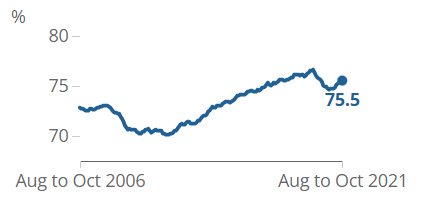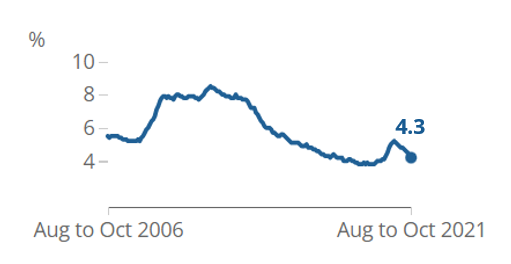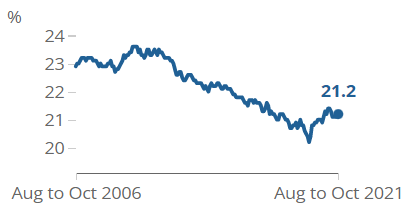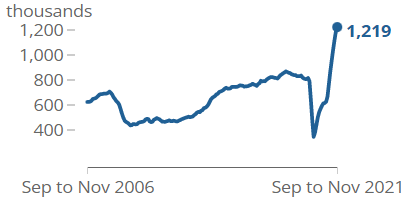Main points
Following a period of employment growth and low unemployment, since the start of the pandemic the employment rate generally decreased, and the unemployment rate increased. However, since the end of 2020, both have shown signs of recovery. Our latest Labour Force Survey estimates for August to October 2021 show the employment rate increased by 0.2 percentage points on the quarter, to 75.5%. The unemployment rate decreased by 0.4 percentage points on the quarter to 4.3%. The inactivity rate increased by 0.1 percentage points on the quarter to 21.2%.
Since the start of the pandemic, the number of employed people has decreased by around 500,000, to 31.2 million people; the number of unemployed has increased by 57,000 to 1.4 million people; and the number of economically inactive has increased by 380,000 to 8.7 million people.
The number of job vacancies in September to November 2021 continued to rise to a new record of 1,219,000, an increase of 434,500 from the pre-coronavirus January to March 2020 level, with 13 of the 18 industry sectors showing record highs. All industry sectors were above or equal to their January to March 2020 pre-pandemic levels in September to November 2021. Health and social care, hospitality, and retail and wholesale were the three sectors with the most vacancies. However, on the quarter, the rate of growth in vacancies continued to slow down and the experimental single month vacancy estimates showed their first reduction in vacancy numbers since February 2021.
Latest indicators at a glance
Employment rate
Employment rate (all aged 16 to 64)
Quarterly change: ▲0.2pps
Since Dec-Feb 2020: ▼-1.1pps

Source: ONS LFS
Unemployment rate
Unemployment rate (all aged 16 to 64)
Quarterly change: ▼-0.4pps
Since Dec-Feb 2020: ▲0.3pps

Source: ONS LFS
Inactivity rate
Economic inactivity rate (all aged 16 to 64)
Quarterly change: ▲0.1pps
Since Dec-Feb 2020: ▲1.0pps

Source: ONS LFS
Job vacancies
Number of job vacancies
Quarterly change: ▲184,700
Since Jan-Mar 2020: ▲434,500
Vacancies increased on the quarter and continue to be at record levels

Source: ONS LFS
Glossary
Economic inactivity
People not in the labour force (also known as economically inactive) are not in employment but do not meet the internationally accepted definition of unemployment because they have not been seeking work within the last four weeks and/or they are unable to start work in the next two weeks. The economic inactivity rate is the proportion of people aged between 16 and 64 years who are not in the labour force.
Employment
Employment measures the number of people in paid work or who had a job that they were temporarily away from (for example, because they were on holiday or off sick). This differs from the number of jobs because some people have more than one job. The employment rate is the proportion of people aged between 16 and 64 years who are in employment. A more detailed explanation is available in A guide to labour market statistics.
Unemployment
Unemployment measures people without a job who have been actively seeking work within the last four weeks and are available to start work within the next two weeks. The unemployment rate is not the proportion of the total population who are unemployed. It is the proportion of the economically active population (those in work plus those seeking and available to work) who are unemployed.
Vacancies
Vacancies are defined as positions for which employers are actively seeking recruits from outside their business or organisation. The estimates are based on the Vacancy Survey; this is a survey of businesses designed to provide estimates of the stock of vacancies across the economy, excluding agriculture, forestry and fishing (a small sector for which the collection of estimates would not be practical).
A more detailed glossary is available.
